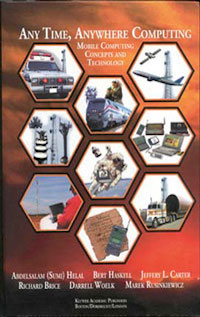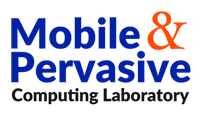Books

Any Time, Anywhere Computing
Mobile Computing Concepts and Technology
Abdelsalam A. Helal
Bert Haskell
Jeffery Carter
Richard Brice
Darrell Woelk
Marek Rusinkiewicz
Kluwer Academic Publishers
September 1999
ISBN 0-7923-9872-6
From the Foreword
Mobile communications have permeated the globe in both business and social cultures. In only a few short years, Japan alone has had more than ten million subscribers enter the mobile market. Such explosive popularity is an indication of a strong commercial demand for communications in both the tethered and tetherless environments.
Accompanying the vibrant growth in mobile communications is the growth in multimedia communications, including the Internet. Mobile and multimedia communications technologies are merging, making mobile computing a key phrase in the coming advanced information communication era. The growth in these dynamic industries shows that a change in our chosen method of communications is already well advanced. Reading e-mail and connecting to various information feeds have already become a part of daily business activities.
We are trying to grasp the overall picture of mobile computing. Its shape and form are just starting to appear as personal digital assistants (PDA), handheld personal computers (HPC), wireless data communication services, and commercial software designed for mobile environments. We are at the cusp of vast popularization of "computers-on-the-go."
Any time Anywhere Computing provides the reader with an understandable explanation of the current developments and commercialization of mobile computing. The core technologies and applications needed to understand the industry are comprehensively addressed. The book emphasisizes three infrastructures: (1) wireless communication network infrastructure, (2) terminal devices (or "computers-on-the-go"), and (3) software middleware and architectures that support wireless and mobile computing.
Moreover, the research activities presented in this book provide an insightful look into the future of mobile computing. I would like to express my sincere applauses to the authors who have completed this enlightening work.
Moriji Kuwabara, Ph.D.
Senior Advisor to NTT President
Nippon Telephone and Telegraph Corp.
Japan
Table of Contents
FOREWORD xi
PREFACE xiii
1 Introduction to Mobile Computing
1.1 Impressive Technology
1.2 Wireless and Mobile Computing Architecture
1.3 Limitations of the Wireless and Mobile Environment
2 Wireless Telecommunication Networks
2.1 Digital Cellular Systems
2.1.1 Time-Division Multiple Access (TDMA)
2.1.2 Code-Division Multiple Access (CDMA)
2.2 The Wireless Network Technology
2.2.1 In-room Infrared
2.2.2 In-room Radio Frequency
2.2.3 In-building Radio Frequency
2.2.4 Campus/Metropolitan Area Packet Networks
2.2.5 Wide-Area Packet/Circuit Switched Data Networks
2.2.6 Satellite Networks
2.3 Mobility-Bandwidth Tradeoffs
2.4 Systems Issues
2.4.1 Multimedia Applications
3 Portable Information Appliances
3.1 Historical Evolution
3.2 The Advent of the PDA
3.3 Palmtop Computers
3.3.1 The Palm Pilot
3.4 Hand-held Computers
3.4.1 Sharp Power Zaurus
3.4.2 VADEM Clio
3.5 Communicators
3.5.1 Nokia 9000
3.5.2 Motorola Marco
3.6 Sub-notebooks (Micro-notebooks)
3.7 Notebooks
3.8 Laptops
3.9 Other Information Appliances
3.9.1 HP CapShare
3.9.2 Clarion AutoPC
4 Future Information Appliances
4.1 New Challenges
4.2 Emerging Portable Information Appliances and Teleservices
4.2.1 Wearable Computing (MIT)
4.2.2 Wearable Computer Systems (CMU)
4.2.3 IBM Wearable PC
4.2.4 BodyLAN: A Wearable RF Communications System
4.2.5 Toshiba Desk Area Network (DAN)
4.2.6 BlueTooth
4.2.7 Seiko Wristwatch PC
4.2.8 NTT PHS Wristwatch Phone
4.2.9 NTT Ring Keyboard
4.2.10 Display Pad: The Next Generation TV
4.2.11 The Ear Phone
4.2.12 Power Ring and the Magic Wand
4.3 Concluding Remarks
5 Future Wireless Communication Networks
5.1 Future Wireless Teleservices
5.1.1 Wireline Network Services
5.1.2 Wireless Service Evolution
5.1.3 Market Evolution
5.2 Emerging Wireless Network Standards
5.2.1 IMT-2000
5.2.2 UMTS
5.2.3 ACTS
5.3 Third Generation Wireless Networks
5.3.1 Time Division/Code Division Multiple Access
5.3.2 Wideband Code Division Multiple Access
5.3.3 Space Division Multiple Access
5.4 Fourth Generation Wireless Research
5.5 Concluding Remarks
6 State of Industry: Mobility Support Software
6.1 Competing Philosophies
6.2 End-User Client Applications
6.2.1 Oracle Mobile Agents
6.2.2 Oracle Lite
6.2.3 Oracle Software Manager
6.2.4 Oracle Replication Manager
6.2.5 Sybase SQL Remote
6.3 Mobility Middleware
6.3.1 MobileWare Office Server
6.3.2 Shiva PPP
6.4 Interoperability and Standardization
6.5 Shortcomings and Limitations
7 Research in Wireless and Mobile Computing
7.1 Mobile Networking
7.1.1 Early Approaches: Virtual IP Protocols
7.1.2 Loose Source Routing Protocol
7.1.3 The Mobile Internet Protocol (Mobile-IP)
7.1.4 Cellular Digital Packet Data (CDPD)
7.1.5 The GSM General Packet Radio Service (GPRS)
7.1.6 Security and Authentication Issues in Mobile Networks
7.2 Quality of Service in Mobile Networks
7.2.1 Optimizing TCP/IP for Mobile Networks
7.2.2 QoS Driven, High-Level Communication Protocols
7.2.3 QoS Driven, Full Protocol Stacks
7.3 Mobile Access to the World Wide Web
7.3.1 The Wireless WWW (W4)
7.3.2 Dynamic Documents
7.3.3 Dynamic URLs
7.3.4 Mobile Browser (MOWSER)
7.3.5 WebExpress
7.4 Mobile Data Management
7.4.1 Mobile Client/Server Data Access
7.4.2 Mobile Data Access in Ad-hoc Networks
7.5 Mobile Transactions
7.5.1 Reporting and Co-Transactions
7.5.2 The Kangaroo Transaction Model
7.5.3 The Clustering Model
7.5.4 Isolation-Only Transactions
7.5.5 The Two-tier Transaction Model
7.5.6 Semantic-based Nomadic Transaction Processing
7.6 Mobile Computing Models
7.6.1 The Client/Server Model
7.6.2 The Client/Proxy/Server Model
7.6.3 The Disconnected Operation Model
7.6.4 The Mobile Agent Model
7.6.5 The Thin Client Model
APPENDIX-A: GLOSSARY OF COMMON ABBREVIATIONS
APPENDIX-B: WIRELESS CELLULAR SYSTEMS
APPENDIX-C: STANDARDS ORGANIZATIONS
REFERENCES
INDEX
